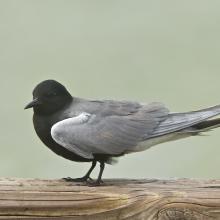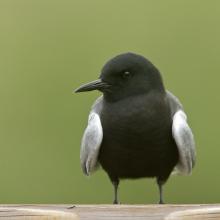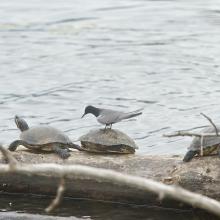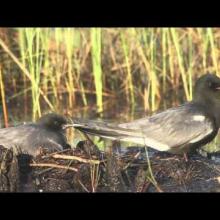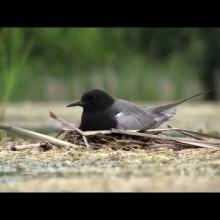

Join BirdNote tomorrow, November 30th!
Illustrator David Sibley and actor H. Jon Benjamin will face off in the bird illustration battle of the century during BirdNote's Year-end Celebration and Auction!
Elegant Black Terns breed in summer on secluded wetlands across the northern states and Canada. Because of major losses of wetlands in their breeding range — especially in Canada's prairie provinces — Black Tern numbers have dropped dramatically since the 1960s. The future of this beautiful bird depends on protecting and restoring high-quality wetlands. Recent research shows that artificial nest platforms can enhance the terns' breeding success.
BirdNote®
The Exquisite Black Tern
Written by Bob Sundstrom
This is BirdNote.
[Calls of Royal Terns]
We’re hearing the calls of Royal Terns. The birds we call terns look like sporty versions of gulls. Like gulls, most terns are feathered gray and white, but terns are more streamlined, with slender, pointed wings and spike-like bills. [Calls of Royal Terns]
The Black Tern carries this sleek look into elegance, cloaking its aerodynamic shape in velvety black. [Black Tern calls]
Black Terns breed in summer on secluded freshwater wetlands across the northern states and Canada. [Black Tern calls in the background throughout] Here they show off another trait that sets them apart: while most terns make a living by plunge-diving for fish, Black Terns, also flutter like swallows over the surface of ponds, snatching insects in mid-air.
Black Terns migrate each spring and fall through the American heartland, traveling back and forth to wintering grounds off the coast of Panama and northern South America. But because of major losses of wetlands in their breeding range – especially in Canada’s prairie provinces – Black Tern numbers have dropped dramatically since the 1960s.
The future of this beautiful bird depends on protecting and restoring high-quality wetlands. [Red-winged Blackbird – wetlands] Recent research shows that artificial nest platforms can enhance the tern’s breeding success, [a strategy now recommended in some states].
You can find more about this research on our website, birdnote.org. Today’s show brought to you by The Lufkin Family Foundation. [Black Tern calls]
###
Bird sounds provided by The Macaulay Library of Natural Sounds at the Cornell Lab of Ornithology, Ithaca, New York. Colony of Royal Terns 138100 recorded by Jessie Barry; calls of Black Terns 48805 recorded by Kevin Colver; Calls of Black Terns 41187 recorded by Geoffrey Keller. Marsh ambient drawn from 57196 recorded by W.W. H. Gunn.
BirdNote’s theme music was composed and played by Nancy Rumbel and John Kessler.
Producer: John Kessler
Executive Producer: Chris Peterson
© 2016 Tune In to Nature.org February 2014/2018/2021 / July 2023
Narrator: Michael Stein
ID# SotB-BLTE-01-2021-2-21
Research on nesting platforms in U.S. https://www.researchgate.net/profile/David-Shealer





